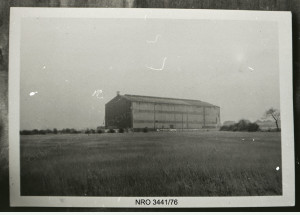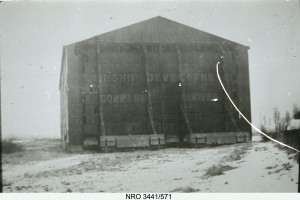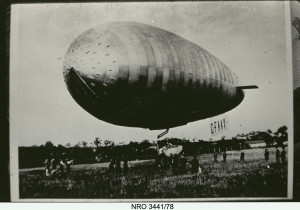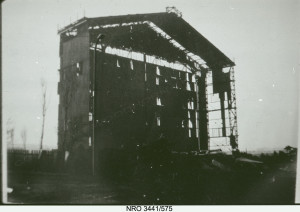In the months leading up to First World War, there was great concern that Zeppelins would wreak havoc on British cities. The other new weapon of war, the submarine was dismissed as being of little threat to the country. The Germans had a relatively small fleet of them in 1914 and it was presumed that the War would be over before they would have time to build many more. The conflict was only a few months old when the Admiralty became alarmed at the increasing number of ships being lost to German submarines. A number of measures were implemented to counter this new menace. They included the construction of a chain of airship stations stretching from Cornwall in the south to the Orkney Islands in the north. Aeroplanes at that time had a very limited range and airships had the advantage of being able to stay airborne for many hours.
There was a large airship station at the entrance to the Firth of Forth at East Fortune. Their machines escorted convoys along the coast as far as Northumberland. Airships from Howden, Yorkshire would then take over responsibility. It was not until 1918, that an airship station was established in Northumberland at Chathill. It was one of several “mooring out” stations that appeared during that year. Sometimes the weather would change when the airships from East Fortune reached the vicinity of Holy Island and they would have difficulty in returning to their base. This problem was alleviated by the construction of a base at Chathill. They could divert here if the prevailing wind was against them or wait to rendezvous with a north bound convoy of ships.
Chathill was commissioned on 31st July, 1918 and lay a short distance to the east of the railway station of the same name. Unlike its parent base of East Fortune it was a very primitive affair. There were no sheds to house the airships. Instead clearings were made in the local wood where they could then be moored. The personnel were housed in tents. On 2nd November, 1918, Submarine Scout Zero S.S.Z.59 had to be quickly deflated when a gale blew up. By this date Chathill was being used frequently by this class of small non rigid airships. It was intended to erect two small portable airship sheds here and have three Submarine Scout Zero and two Submarine Scout Twin airships operating from this location by the summer of 1919. The end of the War put paid to these plans and Chathill was abandoned shortly after the end of hostilities.
In 1917, the Admiralty drew up an ambitious plan to create a large fleet of rigid airships which would be the British equivalent of the Zeppelins. Large sheds to house them would be built at a number of locations including Northumberland and Yorkshire. The lack of enthusiasm in some quarters of the War Office coupled with the shortage of steel for new sheds ensured that these plans never became a reality.
 Some rigid airships were built and operated from a small number of sites. A modest scheme was given approval to create further bases for the smaller non rigid airships at Killeagh (Southern Ireland), Moreton, (Dorset) and Cramlington, (Northumberland see image). At the latter site, an airship station was constructed next to the London to Edinburgh railway. On the opposite side of the tracks was Cramlington Aerodrome.
Some rigid airships were built and operated from a small number of sites. A modest scheme was given approval to create further bases for the smaller non rigid airships at Killeagh (Southern Ireland), Moreton, (Dorset) and Cramlington, (Northumberland see image). At the latter site, an airship station was constructed next to the London to Edinburgh railway. On the opposite side of the tracks was Cramlington Aerodrome.
Most major airship bases and aerodromes in First World War, were in fact located close to a railway. A siding lead off from the main line to serve the airship station. A single Coastal class airship shed was constructed which was 358 feet long and 110 feet wide. It was reportedly painted a brownish colour.  There was a small hydrogen gas making plant in a building behind the shed. It was intended to eventually base four non rigid Submarine Scout Twin airships here. The complement of the airship station was to be 20 officers and 281 men. the First World War ended before Cramlington became operational. Like most other airship stations in Britain it was hastily abandoned.
There was a small hydrogen gas making plant in a building behind the shed. It was intended to eventually base four non rigid Submarine Scout Twin airships here. The complement of the airship station was to be 20 officers and 281 men. the First World War ended before Cramlington became operational. Like most other airship stations in Britain it was hastily abandoned.
In the early 1920’s a company considered using the facilities to operate an airship service to Norway but nothing came of this plan. Some of the buildings were used as a hostel for miners. The closing years of that decade saw a revival of its fortunes. A small enterprise which went by the name of British Airships Ltd.; which later changed its name to the Airship Development Company thought it could revive the fortunes of the small non rigid airships. They constructed an airship designated the A.D.1 in the airship shed at Cramlington. The machine was 138 feet in length and maximum diameter of 29 feet .It was advertised as being suitable for private flying, passenger flights, instruction, advertising , aerial photography and surveying. The main revenue was anticipated to come from advertising and for this role it had panels on its side measuring 76 feet by 24 feet.
 The A.D. 1 first flew on 13th September, 1929 bearing the registration G-FAAX. The following month it appeared at the Newcastle Air Pageant where it circled with its engine throttled back and was so quiet that the spectators could hear the two crew talking to each other. During the following summer it left Cramlington for the south of England to demonstrate its capabilities. Construction was also started on a second airship, the A.D.2.
The A.D. 1 first flew on 13th September, 1929 bearing the registration G-FAAX. The following month it appeared at the Newcastle Air Pageant where it circled with its engine throttled back and was so quiet that the spectators could hear the two crew talking to each other. During the following summer it left Cramlington for the south of England to demonstrate its capabilities. Construction was also started on a second airship, the A.D.2.
The Airship Development Company, however was liquidated at the end of 1930 having overestimated the demand for its services. Britain at the time was in deep recession. The two airship envelopes were sold to be made into dust sheets for furniture and the airship shed at Cramlington vacated ,never to be used again by airships.
Towards the end of its days, the airship shed was used by a firm called Concrete Utilities Ltd ., to make concrete lamp posts. It was eventually demolished in 1967 having outlived its contemporaries by many years. Most other airship sheds had in fact disappeared by the outbreak of World War II.
We would like to express our sincere appreciation to Malcolm Fife in supplying this article for the Northumberland At War Project.


Thank you to Malcolm Fife and the Northumberland at War Project for publishing this very interesting account of Airship Bases and Sheds. I have a lasting memory of a distant view of the Airship Shed at Cramlington. My family and I used to travel by bus regularly from Morpeth to Seaton Delaval during WW2 to see my paternal grandparents (I was born in 1938). To this day I can remember my father pointing it out to me through the bus window saying “Look Ted, that used to be an airship shed!” – seemingly on every journey we took! I never tired of eagerly looking – part of the adventure and fun of travelling with my family. It is splendid to read this history.
Thank you for your comments Ted glad you enjoyed Malcolm’s article.
Late in 1967 I came from London to work on construction sites in the north east. The first site was in Cramlington. I heard about the airship shed on the local news and that it was going to be demolished. So my workmate and I made a visit one lunchtime. We climbed right up inside the shed on the stairs and walkways. My main memory is of the noise of the badly rusted corrugated sheets flapping in the strong wind. Stupidly unsafe really, but you do things like that when you’re young. These days the place would be securely fenced. I seem to remember that, within a few days of our visit, the shed was demolished. Glad I saw before it came down though.